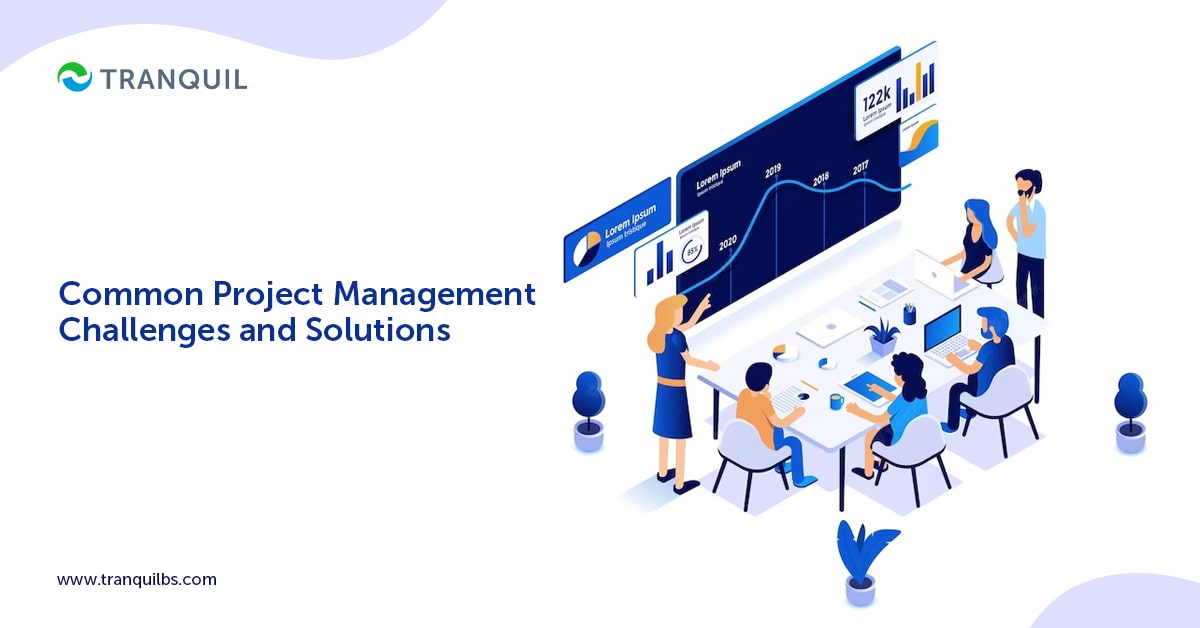
Any project that fulfills the requirements agreed upon, is completed in time, and is within budget, can be said to have been executed successfully.
In the course of the project implementation, it’s quite possible that your team will face several problems at various stages, threatening to hamper the success of the project.
The project manager is responsible for predicting and foreseeing potential problems, and have backup plans ready to tackle them.
Project management is a complex process spanning several stages, the chief ones being initiation, planning, implementation, monitoring, and closure.
Project management challenges can occur at any of these stages.
ALSO READ: Keys To Make Project Management Success
Let us look at the most common challenges you are likely to face in a project, and how to handle them.
When the scope of a project goes beyond its original scope and goals, there is said to be scope creep, and usually happens when clients or other stakeholders want extensive or frequent changes made.
Sudden or frequent changes in the course of project execution can lead to confusion, raise the cost of the project and make it impossible to meet milestones and deadlines.
If you eliminate scope creep, you will be able to ensure the completion of the project in time and within budget.
It is essential to engage proactively with stakeholders at the outset and understand their exact requirements and expectations.
Define the goals and requirements clearly and draw up a schedule showing each step in the process.
Ensure to involve the stakeholders in planning the project.
You also must accurately plan allocation and usage of resources and talent, and make it a rule to not accept ad-hoc requests for change during the execution of the project.
Use Gantt charts, project management software, and other tools to plan and track projects to make sure you are right on track.
Communicate to the stakeholders how changing the scope mid-way can impact budgets and deadlines, and clearly but politely refuse to accommodate major changes that may extend the deadline, hike up the cost, or create confusion.
ALSO READ: Guide on Mobile CRM

This is one of the most common project management problems and can throw the whole project out of whack if left unaddressed.
A project manager with poor communication skills is unable to give proper instructions, take feedback, collect information, and convey appropriate messages to stakeholders.
This can cause a lot of upheaval, chaos, misunderstandings and conflicts, and can lead to delays in project execution.
The best way to improve communication is to use project management software that has inbuilt collaborative and communication tools, allowing all the relevant team members to access important information from the unified communication board.
Project managers must not only give regular feedback about their teams’ performance, but also take feedback from them regarding any issues they may be facing.
The manager must also be adept at conveying messages to stakeholders properly and keeping them updated about the progress of the project.
PMs can also conduct team-building activities to enhance communication between team members and foster collaboration and better relationships.
It is important to be transparent about the project – whether it is progress or problems; a good project manager will use the appropriate method or approach of communication to suit different types of people.
ALSO READ: Key Features of Accounting Software

For projects to be successful, it is imperative that there are measurable and well-defined goals that the team can work toward.
Often, the goals are unclear to many of the employees involved in the project, and don’t know what the customer is expecting.
This could cause the team to waste time and resources in chasing goals that are not the ones the stakeholder desired at the outset, and don’t deliver any value.
There are two main approaches to goal setting for organizations – CLEAR and SMART.
CLEAR stands for collaborative, limited, emotional, appreciable, and refinable.
SMART stands for specific, measurable, attainable, relevant, and timely.
Either approach or a combination of the two can be used by project managers to set goals that can guide employees and team towards timely project completion.
The project can be broken down into smaller, simpler tasks; the most suitable people can be assigned to those tasks, and the goals and objectives must be clearly explained to them.
The specifications and timeline of the project must be defined before the execution begins, and you must hold a team meeting to define and discuss the goals, and follow up to reiterate them at intervals.
You can use reliable project management software like Tranquil to clearly define goals and the role of each team member in attaining them. You can also identify methods to track progress.
ALSO READ: Emerging HR Trends
When financial planning is haphazard and cost is not managed properly, the funds allocated for the project are not used properly.
This means you are unlikely to achieve the desired outcomes.
With improper handling of money, your project may well overshoot the budget, which will not go down very well with your stakeholders – not to mention that it could negatively impact your project completion.
The budget changes whenever there are sudden requests for changes in the project – what we refer to as scope creep.
Ergo, managers need to have contingency plans in place to accommodate for a little scope creep and budget for that right at the beginning.
You must consider that some changes may be inevitable and make allowances at the planning stage.
You can use budget tracking software or the trackers in our project management tool to ensure that you stay within budget.
It is important to plan the budget early on and be realistic in estimates.
You can review projects similar to yours and compare their budgets, and also take expert advice from QA specialists or developers who are well versed with estimating time and cost for projects like yours.
You may also need to reassign resources, change vendors or services, etc. as required.
ALSO READ: Guide on Cloud Migration
It may so happen that the skills or level of skills required to successfully execute the project are lacking in your employees – this is what we call a skill gap.
When employees are unable to perform their roles, there will be a gap between the goals and outcomes of your project.
Start by making up a list of the knowledge or skills the project requires for successful completion, and assess the skills your team members have.
Provide necessary training to bridge the skill gap so that your project can progress smoothly.
Make sure to match employees to tasks based on their skills and expertise, and hire additional staff if required to close the skill gap and ensure timely completion.
ALSO READ: Cost Effectiveness Vs Cost Efficiency

Conducting risk analysis is important so that potential issues can be predicted; this is a critical part of the project, yet it in itself is open to some risks.
If you hurry through with the analysis, you may not be able to properly foresee major hinderances that can crop up.
This can cause any number of problems – financial or otherwise.
It is important to research the potential project management challenges that you may face at different stages, and create plans and measures to mitigate and prevent those risks.
Have backup plans in case changes are made to the original project.
It also helps to know what resources are at your disposal to be able to control and minimize these risks.
ALSO READ: What is Total Cost of Ownership (TCO)?
It is important for employees, regardless of which level they are at in a company, to take responsibility for their mistakes.
It is important to know who made the mistake, as they need to face the consequences of their actions Sometimes, even seemingly small mistakes may lead to huge problems eventually.
When accountability can’t be fixed on a single individual or group, the entire team may get blamed for it – and this can impact team morale, impacting productivity, as time, resources, and effort are wasted in trying to find out the cause and eventually a solution.
It is important to be very clear about the tasks you assign to each member, and also set common goals which your team has to work toward.
Ensure there is accountability in the workflow of your project so that all employees have clarity regarding their roles and responsibilities.
Lead by example, accept your mistakes, so that employees understand its alright to go wrong as long as you take ownership for them and rectify them.
Create trust between team members so that everyone is transparent and comfortable.
ALSO READ: Importance of Fixed Asset Tracking

In some cases, stakeholders are not involved in the planning or execution of the project, leading to a lack of communication and collaboration with the project team.
This means no inputs to guide the team towards the ideal outcome, and can also lead to improper risk analysis and unclear goals.
Stakeholder engagement is critical to a project success, so you must involve them in the project right from the initiation and planning stages.
Make sure you communicate frequently with them, updating them about the progress of the project regularly.
Get feedback from them at every stage and ask them for inputs and recommendations so that you can get the desired outcomes from the project.
ALSO READ: Strategies to Improve Your Supply Chain
Sometimes, either overenthusiastic project managers or customers in a hurry demand the project be completed within unreasonable due dates; it is humanly impossible to complete the project with the given requirements and specifications within that time.
This often leads to hurried activities and short-cuts, compromising work quality.
Consequently, the project completion will be slapdash and will not achieve the desired outcomes and expectations.
Learn to set priority to tasks – think which are the most important.
Plan for possible problems and keep a time buffer for your deadline.
Involve relevant employees in fixing deadlines and discuss your concerns about them with stakeholders at the very beginning.
Use a calendar and timeline tool to manage deadlines properly.

This arises when there are conflicting priorities that both need equal time and attention, especially if you are working on several projects simultaneously.
This may lead to multiple projects getting delayed, and problems with resource allocation.
ALSO READ: Different Ways to Improve the Procurement Process
You should coordinate with other OMs regarding the schedules and requirements of your project, and check holiday and time-off schedules of employees to eliminate surprise absences.
You can use the inbuilt calendar in our project management tool to organize different projects and their requirements simultaneously.
Project management software is the need of the hour to ensure successful planning, management, and completion of projects.
It is essential to choose robust, cloud-based business software like Tranquil to avoid delays, enhance communication and collaboration, and ensure smooth execution of your project.
ALSO READ: Benefits Of Software As A Service
Tranquil ERP’s project management module allows you to track time, and schedule tasks, has inbuilt communication tools, integrates with your other business tools, and can be customized to suit your requirements. It’s an affordable and robust tool that can help you save time, effort, and money, and streamline your project management. Schedule a FREE demo to know more!